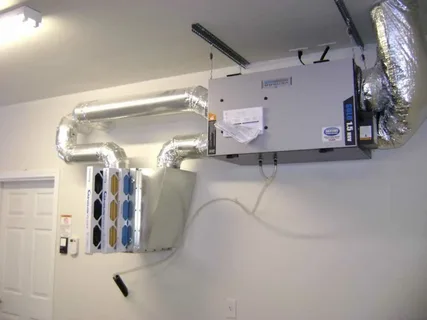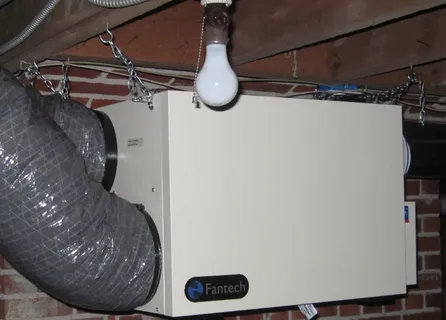A house fresh air system is a must-have for anyone looking to transform their home into a haven of freshness. This system not only helps circulate clean and fresh air throughout the house but also plays a vital role in improving indoor air quality. This blog post will delve into the importance of fresh air in homes, how fresh air systems work, the different types available, and the health benefits of installing one. They will also discuss the energy efficiency of these systems, key considerations before installation, maintenance tips, and how whole-house air exchangers can help maximise indoor air quality.
The Importance Of Fresh Air In Homes
The significance of fresh air within domestic environments cannot be overstated. It plays a crucial role in mitigating indoor pollutants, unpleasant odours, and excessive moisture, thereby fostering a healthier living space. In the absence of adequate ventilation, the air inside homes can become stagnant, laden with contaminants that potentially lead to respiratory complications and other health issues.
A house’s fresh air system ensures a continuous influx of clean, fresh air, enhancing the well-being and comfort of inhabitants. This system is instrumental in maintaining an environment conducive to health, by preventing the accumulation of harmful substances in the air. Consequently, the introduction of fresh air into homes emerges as a fundamental aspect of promoting a wholesome and comfortable living space.
Understanding How Fresh Air Systems Work
Fresh air systems operate through a mechanism of constant air exchange, which involves introducing fresh outdoor air into the home whilst simultaneously expelling stale indoor air. The process utilises an intricate network of fans and ducts designed to efficiently circulate air across different sections of the house.
As part of this operation, the system actively filters incoming air to eliminate pollutants, allergens, and particulate matter, thereby ensuring that the internal environment remains healthy and pleasant.
A key component of this functionality is the balancing of airflow to maintain optimal indoor air quality without compromising the thermal comfort of the home’s occupants. Through this sophisticated air exchange process, the system supports a living space that is not only refreshing but also conducive to overall well-being.
Different Types Of Fresh Air Systems For Your Home
Within the realm of indoor air quality enhancement, a diverse array of fresh air systems presents itself, offering tailored solutions to various ventilation needs. Amongst these, Heat Recovery Ventilators (hrvs) and Energy Recovery Ventilators (ervs) stand out for their efficiency and utility.
On the flip side, ervs extend the functionality of hrvs by not only transferring heat but also by managing the humidity levels within the premises. This additional feature of moisture control makes ervs particularly beneficial in areas prone to either excessive humidity or dry conditions, as they can add or remove moisture from the incoming air as needed, ensuring a comfortable indoor atmosphere.
Certain homes might benefit more from the moisture-regulating capabilities of ervs, while others might find the temperature control offered by hrvs to be more crucial, depending on the environmental conditions they face.
 Health Benefits Of Installing A Fresh Air System For Home
Health Benefits Of Installing A Fresh Air System For Home
The incorporation of a Fresh air system for home setting heralds a significant advancement in enhancing the quality of life through improved air quality. Individuals residing in environments equipped with fresh air systems experience a notable reduction in the incidence of respiratory disorders, as these systems facilitate the removal of pollutants and allergens that compromise lung health.
Additionally, these installations contribute to the diminution of ailments associated with indoor air pollution, including headaches, fatigue, and irritation of the eyes, nose, and throat.
The consistent circulation of clean air also aids in neutralising odours and diminishing the presence of harmful airborne particles, thereby establishing a living space that supports both physical and mental well-being. The strategic implementation of these systems ensures that homes are not just shelters but sanctuaries that actively promote the health and comfort of their inhabitants.
Energy Efficiency And Fresh Air Systems
Fresh air systems embody the pinnacle of energy-efficient technology, designed with the foresight to economise heating and cooling expenditures. By harnessing the power of heat or energy recovery from outgoing air, these innovative systems substantially lessen the demands placed on HVAC systems.
This reduction in workload translates into decreased energy consumption, which not only contributes to a lower environmental impact but also manifests in significant savings on utility bills over time. The essence of their functionality lies in their ability to maintain a balance between optimising air quality and minimising energy usage.
This approach ensures that the pursuit of a fresher indoor environment does not come at the expense of increased energy costs or a larger carbon footprint. Instead, it presents a harmonious solution that aligns the objectives of enhanced indoor air quality with those of energy conservation and financial savings, making these systems a smart choice for environmentally conscious homeowners seeking to elevate their living spaces.
Key Considerations Before Installing A Fresh Air System
When considering the integration of a house’s fresh air system, several factors merit attention to ensure the selection and installation process aligns with the specific needs and structure of the dwelling.
1. Home Size and Layout
The dimensions and configuration of a residence significantly influence the type of fresh air system required. Systems must be appropriately scaled to efficiently service the entire home without over extension.
2. Local Climate
The environmental conditions prevalent in the area dictate the choice between systems like Heat Recovery Ventilators and Energy Recovery Ventilators. The former may be more suitable for extreme temperatures, while the latter can offer added benefits in managing humidity levels.
3. Air Quality Needs
Identifying specific air quality concerns, such as allergen removal or pollution mitigation, helps in selecting a system with capabilities tailored to address these issues effectively.
4. Energy Efficiency Goals
For households aiming to enhance their energy efficiency, the selection of a system that aligns with these objectives without compromising indoor air quality is paramount.
5. Budget Considerations
Initial installation costs, alongside ongoing maintenance expenses, should be evaluated to ensure the choice remains economically viable over the long term.
Maintenance Tips For Fresh Air Exchange System
Ensuring the sustained performance of a house’s fresh air system necessitates regular upkeep. Key to this is the routine replacement or cleaning of air filters, pivotal for maintaining unimpeded airflow. A periodic examination and cleansing of the ductwork are recommended to prevent the accumulation of dust or debris that could hinder the system’s efficiency.
Attention should also be directed towards the fan and motor components, inspecting for any indications of wear or the need for lubrication to ensure smooth operation.
An annual check-up carried out by professionals is advisable, to certify the system operates at peak efficiency. These maintenance actions are essential for the longevity and effectiveness of the fresh air exchange system, ensuring it continues to deliver clean and healthy air into the home without disruption.
Maximising Indoor Air Quality With Whole House Air Exchangers
In the pursuit of optimal air quality, these exchangers utilise advanced filtration techniques to capture a wide array of airborne contaminants, including dust, pollen, and other allergens. This filtration process is crucial for households aiming to mitigate the effects of airborne irritants on occupants’ health.
Whole house air exchanger stand at the forefront of enhancing indoor air quality, playing a pivotal role in the maintenance of a healthy and energy-efficient living environment. These systems are adept at orchestrating a seamless exchange of stale, indoor air with fresh, outdoor air, thus ensuring a continuous supply of clean air within the household.
The effectiveness of whole-house air exchangers in purging indoor environments of pollutants contributes significantly to the creation of a living space that not only promotes well-being but also aligns with energy conservation goals.
Fresh Air Systems And Allergies
For individuals grappling with allergies, the implementation of fresh air systems represents a significant leap towards ameliorating their condition. These systems, through their dynamic air circulation and filtration capabilities, are instrumental in purging the indoor environment of allergens.
Consequently, individuals suffering from allergies experience a notable enhancement in their quality of life, with a decrease in the frequency and severity of allergic reactions. The environment thus fostered within the home becomes one that supports easier breathing and a significant reduction in discomfort for those sensitive to airborne irritants.
In essence, fresh air systems emerge not just as facilitators of general well-being but as critical allies in the quest for a more hospitable living space for allergy sufferers. This reinforces the perception of the home as a sanctuary, free from the stresses imposed by external allergens, thereby uplifting the living experience for all residents, especially those afflicted by allergies.
Filtering The Air You Breathe: House Air Exchanger
House air exchangers are equipped with advanced filtration systems that play a pivotal role in enhancing the quality of indoor air. These systems adeptly capture and trap a wide spectrum of airborne particles such as dust, pollen, and other potential allergens, ensuring the air within residential spaces remains clean and conducive to health.
The efficacy of these exchangers in maintaining an environment free from pollutants hinges significantly on the regular replacement of filters. This maintenance practice is crucial for preserving the system’s ability to perform its functions optimally.
Consequently, the air that circulates throughout the living spaces undergoes a rigorous purification process, creating conditions that support well-being and comfort. The role of whole-house air exchangers extends beyond merely ventilating spaces; they are instrumental in safeguarding the respiratory health of inhabitants by providing a consistent supply of purified air.
FAQs
1. What distinguishes Heat Recovery Ventilators from Energy Recovery Ventilators?
Heat Recovery Ventilators are designed to exchange heat between incoming and outgoing air, making them ideal for colder or hotter climates. In contrast, Energy Recovery Ventilators also manage humidity levels, making them suitable for areas with significant moisture in the air.
2. How often do filters need replacement in a Fresh air system for home?
The necessity for filter replacement varies depending on usage and environmental factors, but generally, it is recommended to check and possibly replace filters every 3 to 6 months to maintain optimal performance of Fresh air system for home.
3. Can a house’s fresh air system reduce energy costs?
Yes, by recycling energy from outgoing air, these systems can reduce the reliance on heating and cooling systems, potentially lowering energy bills.
4. Are these systems beneficial for allergy sufferers?
Through efficient filtration of incoming air, these systems can significantly reduce the presence of allergens, improving living conditions for individuals with allergies.
5. What is involved in the maintenance of a fresh air system?
Routine maintenance includes filter replacement, duct cleaning, and professional check-ups to ensure the system operates efficiently and continues to provide clean, fresh air to the home.
Conclusion
In summary, the adoption of fresh air systems represents a transformative step towards cultivating a healthier, more comfortable indoor environment. These systems not only facilitate the continuous exchange of stale air with fresh, clean air but also significantly contribute to energy efficiency and the reduction of allergens within the home. With various options available, tailored to different needs and climates, selecting the appropriate system necessitates careful consideration of several key factors. Proper maintenance ensures their longevity and efficiency, reinforcing the home as a sanctuary of well-being. Thus, the integration of a fresh air system emerges as a prudent investment in the pursuit of an enhanced quality of indoor living.
| Other Good Articles to Read |
| Gabrielle Blogs |
| Jason Toff Blogs |
| Thumb Blogs |
| Blog Shifter |
| Social Bookmarking Blogs |
| Blog Solidaire |
| Michael Coyne Blog |
| Born Free Blog |
| Oz Blog Hosting |
| Indepth News |
| Link Forum |
| Related Business Listings |
| Contact Directory |
| Local Business Profiles |



